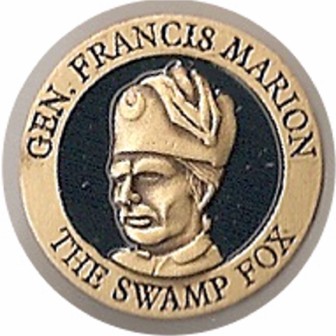 Finding presenters &
plans are in progress for Francis Marion Symposium Oct. 14-15,
2011
Finding presenters &
plans are in progress for Francis Marion Symposium Oct. 14-15,
20119th Francis Marion/Swamp Fox Symposium: |
||||||||||||||||||||||||||||||||||||
| Immerse yourself
in Francis Marion's world
and learn the significance of the Southern Campaign
of the American Revolution. |
||||||||||||||||||||||||||||||||||||
| Look: Revolutionary
War Enthusiasts!!
Call for Papers. Read on. The prime topic areas focus is on Marion, explanations of the engagements and the war in South Carolina. Gen. Francis Marion played a major role in the American Revolution. Many of these engagements took place in the Clarendon County area. According to Professor Henry Lumpkin about a third of all battles were fought in SC and Marion had a hand in roughly a third of those. Topics relative to Marion & the Southern Campaign are considered. Plan & submit what you can present. Consider that you may need Toast Master experience. 9th Francis Marion Symposium October 14-15, 2011 Mail your proposals to: Attn: Francis Marion Symposium c/o C. Hester, PO Box 667, Manning, SC 29102 Link for symposium_proposals_form to print. |
||||||||||||||||||||||||||||||||||||
| Topics nearing completion
and being considered for presentations: Early Rev. Churches, Maps of Colonial Plats along the Santee, Charles Cotesworth Pinckney and Marion in various locations and new research. |
||||||||||||||||||||||||||||||||||||
| Make plans to come:
9th Francis Marion Symposium October 14-15, 2011 Mail your registrations to: Attn: Francis Marion Symposium c/o C. Hester PO Box 667, Manning, SC 29102 Link for symposium_registration_form to print |
||||||||||||||||||||||||||||||||||||
| 9th Francis Marion
Symposium Register for October 14-15, 2011 (Lectures, reception, lunch & dinner theater) Price: $ 95 ($175 / couple) (Early bird $90/$165 by Sept 22) Registration closes 10/3/11 |
||||||||||||||||||||||||||||||||||||
| Agenda in progress: Friday,
October 14, 2011 Agenda to be completed
soon. 2:00 PM Registration / Sign-In / Welcome folders / Intros 2:30 PM Christine Swager: British Intentions Thwarted: How it all went wrong in SC 3:30 PM Watkins & Queen w/ moderators: Plats & maps of 1750’s Santee River 4:30 Depart for Tour enroute to Reception/Dinner 6:00 PM Reception, with Dinner in Manning Saturday, October 15, 2011 9:15 AM Opening, Drinks & Breakfast Snacks / Intros: 9:30 AM & 10:30 AM & 11:30 AM Presentations 12:30 PM Discussions and Lunch 2:00 PM & 3:00 PM & 4:00 PM Presentations 5:00 PM Displays/ Book Signings 6:30 PM An Evening in Revolutionary War History Dinner Theater with Dr. Joe Stukes as Charles Cotesworth Pinckney Site: DuBose Campus / Central Carolina Tech Col. Manning, SC. |
||||||||||||||||||||||||||||||||||||
| You missed
the best one yet. 8th Francis
Marion/Swamp Fox Symposium:
8th Francis Marion Symposium: "Explore General Marion and the Southern Campaign" Immerse yourself in Francis Marion's world and in the significance of the Southern Campaign of the Revolutionary War. Approx. Times: Friday, Oct. 15, 2010: 2 PM - 9 PM and Saturday, Oct. 16, 2010: 9 AM - 10 PM 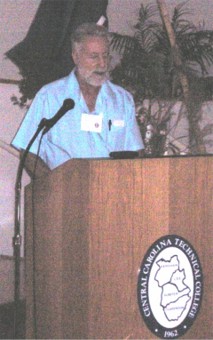 Site:
FE DuBose Campus
of
Central Carolina
Technical College,
I-95, Exit 122, ½
mi
E
on US 521, Manning, SC.
Site:
FE DuBose Campus
of
Central Carolina
Technical College,
I-95, Exit 122, ½
mi
E
on US 521, Manning, SC.
Agenda: Friday, October 15,
2010
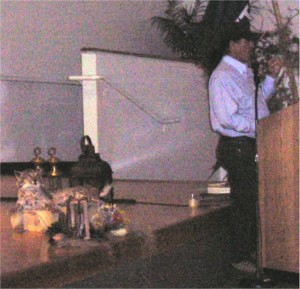
V. Green: Famous Indian town called Cofitachequi Saturday, October 16, 2010 P. Proctor: A Revolutionary War Backcountry Woman During the War W. Turbeville: Christopher Gadsden G. Poteat: Marion and his Intelligence Network - CIA Photos by G. Summers of Swamp Fox Murals D. Neilan: Marion letters & research N. Davies: Much Ado About Potatoes K. MacNutt: Marion Images, Including Family Resemblances
An Evening in Rev. History Dinner
Theater With Our Favorite Historian J.
Stukes as Otho Williams
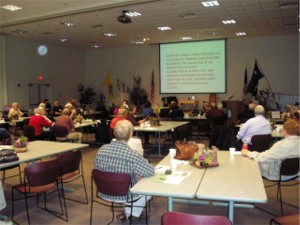
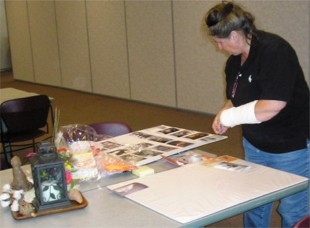
Sponsors 2010:
Bank of Clarendon,
Manning; J & N Black,
Manning; R. Bradshaw of Manning;
Citizens Bank, Turbeville;
DuBose Campus, Central Carolina
Technical College, Manning; Don
Ellis, CPA, Manning; Farmers
Telephone Coop, Kingstree; The Clarendon
Citizen; In Honor of
Rep. C. Harvin, Summerton; Manning IGA,
L. Kennedy; Manning Restaurant; NBSC,
Manning; Prothro
Chevrolet, Manning; G & C
Summers, Manning; Turbeville IGA Plus,
H. Smith; Turbeville Ruritan Club;
and W & D Turbeville, Manning.
|
||||||||||||||||||||||||||||||||||||
|
Payment: Make check payable to Francis Marion Symposium (non-refundable after 10/8/11) Mail to: Francis Marion Symposium, PO Box 667, Manning, SC 29102 Questions call 803-478-2645 or E-mail gcsummers@ftc-i.net Book your own room and advise motel
you are attending symposium
for the special rates.
|
||||||||||||||||||||||||||||||||||||
| DVD Videos,
including this last year's Symposium, are NOW available:
2 years for $25, 1 for $15 |
||||||||||||||||||||||||||||||||||||
In Clarendon Citizen
- October 19, 2010 - By Chuck Waters 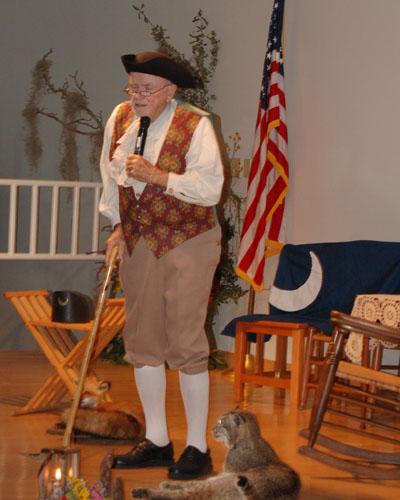
Marion Symposium a hit again The eighth Francis Marion Symposium was a great success - again. That is the thought of organizer George Summers of Manning. He and his wife, Carole, and a group of dedicated volunteers have been putting the symposium together for eight years and despite successful events in the past, this one ranks up there with the best. People from all across the country came to Clarendon County to listen, learn and even eat from the Revolutionary War era. “All the presenters were exceptionally good this year,” said Summers. “It went better than we thought it would go. We had high expectations, but we exceeded those. It really came together this year.” Chuck Waters/"The Clarendon Citizen" -
Dr. Joseph Taylor Stukes is seen portraying
The Summers received an email from a Charles
Baxley, lawyer in Camden, commending them on their work to make
the symposium a great experience. His email read, “I thoroughly
enjoyed this year’s Francis Marion Symposium. The pace seemed to
be more relaxed this year. I thought the atmosphere was terrific. Thanks
for all your hard work for making it happen.”Continental Army Officer Otho Williams during the Francis Marion Symposium. Stukes spoke about Williams’ career, life and his role in strengthening the south. The Summers received numerous emails from other
people also expressing their enjoyment of the event. Many of them have asked
about future events and things
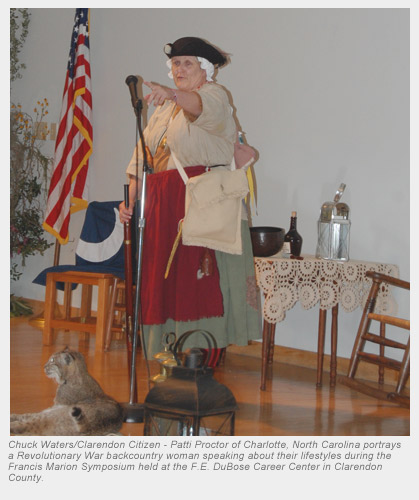 they can do to prepare for the future.
they can do to prepare for the future.
The first was from John Parker; author of Parker’s Guide to the Revolutionary War in S.C. and the second was from Val Green speaking about the ancient Indian town named Cofitachequi. The night ended with a meal and a meet and greet event at the Manning Restaurant. “I think this guy (Baxley) probably mirrors everybody,” said Summers. “They really liked the dinner at Manning Restaurant Friday night. They had a great time of fellowship and the food was tremendous.” According to Summers, the highlight was Dr. Joseph Taylor Stukes’ portrayal of Otho Williams Saturday evening. Stukes entered the stage following the dinner and portrayed Williams about being a military leader alongside Marion in the South. 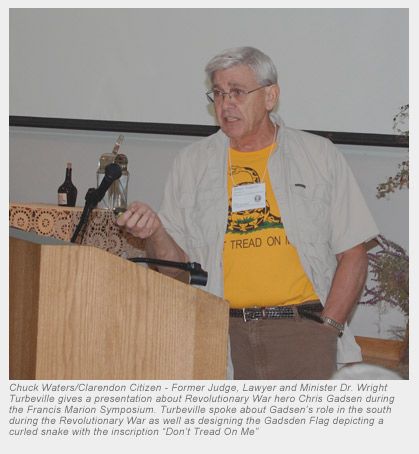
“Every presenter had stuff they’d dug out in their research that I personally had never heard before,” Summers said. The South had an important role in the American Revolution and Summers said that a focal point of the symposium. Gaining a better and clearer perspective on this area and what role it played in the Revolution to aid in the formation of the country was something the Summers and each participant aimed for. “I think the participants took away a greater appreciation for the part of South Carolina played in the American Revolution,” Summers said. “In particular, the Southern Campaign of the American Revolution. The action was in our area of South Carolina. I think that was fairly evident to everybody.” With the success of the symposium and great feedback from attendees, Summers definitely wants to put together a ninth symposium. Even though they do not begin the planning process until the spring, the organizers have ideas and interested individuals possibly lined up. “I don’t think we’ll change it much,” Summer said. “We’ll have different presentations with different presenters; but the format will stay the same. After eight years, we have the schedule worked out. “We already have people talking about what they’re doing in their research and what they would like to present.” |
||||||||||||||||||||||||||||||||||||
|
2009 Agenda Presentations: Happened not to be the Last Symposium, great fun & history info: 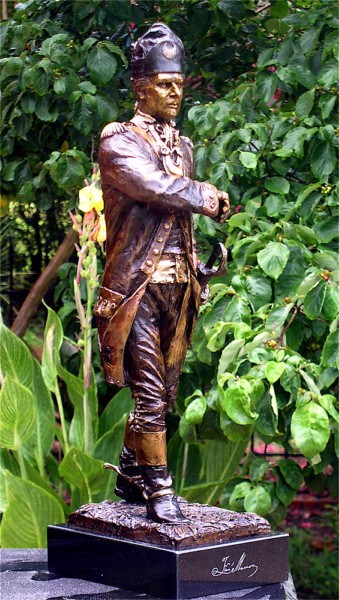 Friday, October
16, 2009
Friday, October
16, 2009
Presentations:
C. Swager: Francis Marion: Stranger Than Fiction W. Turbeville: John Laurens: The Real Revolutionary Reception/supper in the country with tour enroute Saturday, October 17, 2009 G. Summers: Marion’s Bridges Campaign, Escalating Tactics T. Powers: Marion and His Commanders W. Graves: Rev. War Pensions Applications and Research Discussions/ Lunch K. MacNutt: Gen. & Mrs. Marion, Families of the Revolution D. Neilan: The Crisis of Command in the Southern Department & Marion correspondence D. Sherrill: Dr. Benjamin Franklin's historical presentation: Politics of War Displays/ Book Signings Dinner: An Evening in Rev. History Dinner Theater With Joe Stukes as Maj. John James of Marion’s Brigade Sponsors 2009:
Bank of Clarendon, Manning;
J & N Black, Manning; DuBose
Campus, Central Carolina Technical College,
Manning; Don Ellis, CPA, Manning;
Elliott's Landing, Pinewood;
Farmers Telephone Coop, Kingstree;
Representative Cathy Harvin,
Summerton;
The Manning Times; Manning IGA,
Lamar Kennedy; Midway Presbyterian Church,
New
Zion; NBSC,
Manning; Prothro Chevrolet, Manning;
G & C Summers, Manning;
The Tearcoat Framery, Manning;
Turbeville IGA Plus, H. Smith;
Turbeville Ruritan Club; and W & D
Turbeville, Manning. |
||||||||||||||||||||||||||||||||||||
|
|
||||||||||||||||||||||||||||||||||||
You missed a good one,
which exceeded our expections.
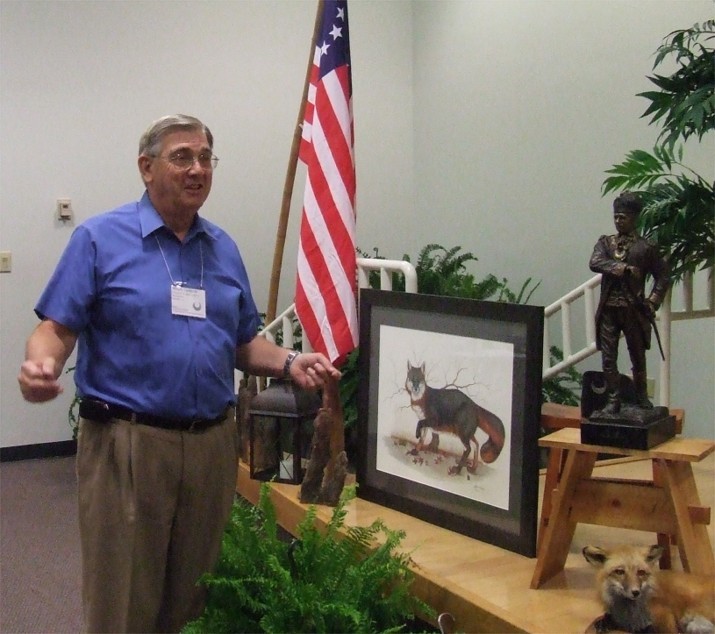
“Explore the Rev. War Southern Campaign, Marion & his Contemporaries” Immerse yourself in Francis Marion's world and learn from his contemporaries: Horatio Gates, Nathanael Greene, John Rutledge (In person), Hezekiah Maham, as well as the modern applications of Marion; the Significance of Francis Marion; Lawyers and the Revolution; the South Carolina Militia and An Evening in History With Mary Esther Videau, Life at Pond Bluff with the General. Approx. Times: Friday Oct 10, 2008: 2 PM-10 PM and Saturday Oct 11, 2008: 9 AM-10 PM 6th Francis Marion/Swamp Fox Symposium Oct 10-11, 2008 “Exploring the Southern Campaign with Marion and His Contemporaries” DuBose Campus, Central Carolina Technical College, I-95, Exit 122, ½ mi E US 521, Manning, SC Program/Agenda Friday, October 10, 2008 Presentations: C. Swager: Significance of Marion in the eventual defeat of Cornwallis 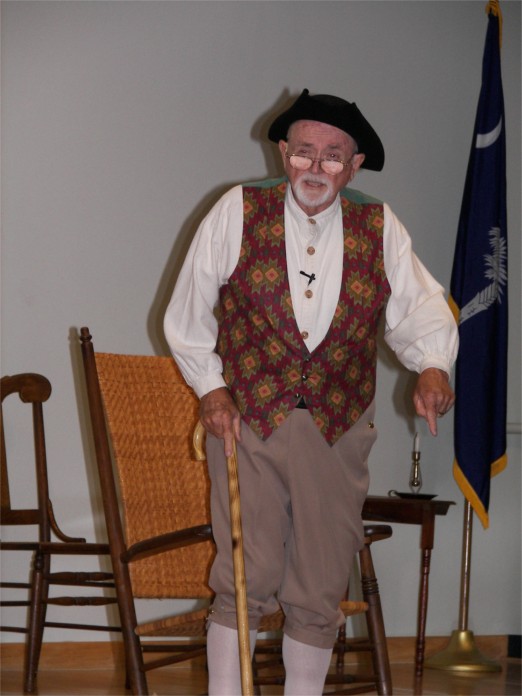
G. Summers: An Entrepreneur: Francis Marion lessons in a modern economy Depart for Tour Old River Road, Half Way Swamp, Richardson Cemetery Reception with Indian Artifacts exhibition and Hors d’oeuvres: Reception, with a tour of sites and murals enroute. Saturday, October 11, 2008 W Turbeville: Lawyers and the Revolution T. Powers presents Horatio Gates J. Liles presents Nathanael Greene Discussions and Lunch S. Bell: The S.C. Militia: From Victory to Defeat & Defeat to Victory J. Stukes portrays John Rutledge W. Montgomery: Col. Hezekiah Maham as Patriot, Frontier Soldier, Engineer. Displays/ Book Signings Dinner and An Evening in Revolutionary War History with Mary Esther Videau (Mrs. General Marion) at Pond Bluff by K. MacNutt and Visitor by C. Swager Remember you’re in the backcountry with the militia, so be comfortable. (Casual or Rev. History clothes if you like) 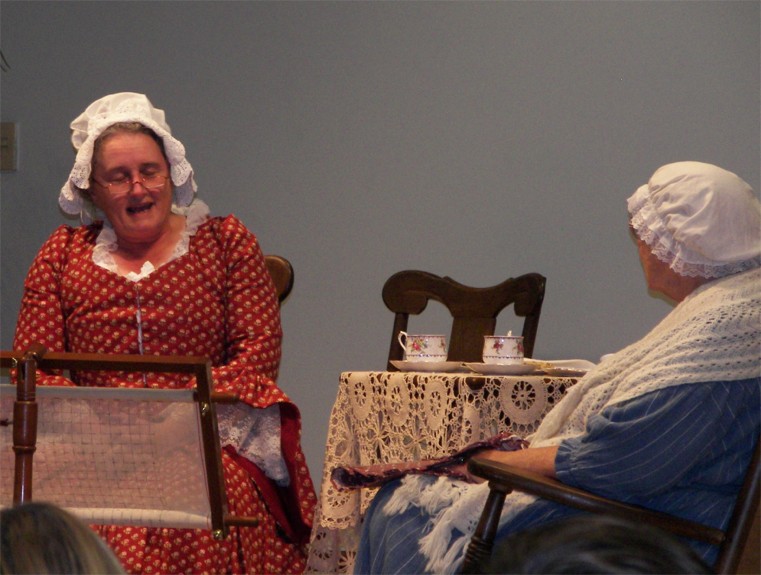
Inclusions: All Presentations Friday & Saturday - Friday – Reception, including heavy Hors D’oeuvres - Saturday - Breakfast snacks - Saturday – Lunch - Saturday - Dinner Theater Presentations @ FE DuBose Campus, Central Carolina Technical College, I-95, Exit 122, ½ mi E on US 521, Manning Questions: George: 803-478-2645, cell: 919-730-3533 or gcsummers@ftc-i.net Mail registration to: C. Hester: 6th Francis Marion Symposium PO Box 667 Manning, SC 29102 Sponsors 2008: Bank of Clarendon of Manning; Jim and Nell Black of Manning, DuBose Campus, Central Carolina Technical College of Manning; Edward Jones, Randy Bradshaw of Manning; Don Ellis, CPA of Manning; FTC – Farmers Telephone Coop of Kingstree; Representative Cathy Harvin of Summerton, Manning IGA, Lamar Kennedy of Manning; The Manning Times, NBSC of Manning, Prothro Chevrolet Co., Inc, Lannes Prothro of Manning; South Carolina Waterfowl Association, Camp Woodie of Pinewood; George & Carole Summers of Manning; Turbeville IGA Plus, Hugh Smith of Turbeville. Site: FE DuBose Campus of Central Carolina Technical College, I-95, Exit 122, ½ mi E on US 521, Manning, SC. All events included: $95/person, $165/ Couple, Early Bird Fee by 9/21/08: $85 / person ($155 / couple). |
||||||||||||||||||||||||||||||||||||
6th annual Francis Marion Symposium draws national crowd By Cathy Gilbert of The Manning Times 10-16-08 Visitors from as far away as Wisconsin, Michigan, Florida and Massachusetts descended upon Clarendon County last weekend to take part in the sixth annual Francis Marion Symposium, presented by the Swamp Fox Mural Trails Society. Held at F.E. DuBose, the Symposium drew more than 150 attendees who clamored to learn more about their hero, Francis Marion and his compatriots, including Horatio Gates, Nathaniel Greene, John Rutledge and Hezekiah Maham, all names very familiar to Revolutionary War buffs. Friday’s presentation was supposed to include a comparison of Marion’s guerilla war tactics to methods for modern day entrepreneurs. Although the presenter had to cancel at the last minute, Symposium organizer George Summers never missed a beat and made the presentation himself. “The most important thing any businessperson can do is to set goals and plan,” Summers said. “In these scary financial times, everyone needs a contingency plan.” Summers said that like Marion, we most know what our assets are. “With a very small band of warriors, Marion was able to keep 1,500 British soldiers tied up all the time. Marion figured out that it was most important to be able to move and feed his troops. If he could do that, he could employ his famous ‘hit and run’ tactics to great success.” Operating in business today is no different, according to Summers. “Marion succeeded by making friends with the populace; that is today’s customer service. He knew how to pick his targets. That is today’s successful market analysis. He knew he had to use unconventional tactics. That is today’s creative thinking,” Summers said. The Friday session concluded with a driving tour to Ft. Watson via the Old River Road in Summerton. A reception was held at Camp Woodie after the tour. Saturday morning kicked off with a humorous look at lawyers in Revolutionary War time, presented by Judge Wright Turbeville. Turbeville said that lawyers were not the most popular of professionals in Colonial days. “It was then as it is now … 99 percent of lawyers give the rest of us a bad name,” Turbeville joked. Colonial lawyers were often the sons of wealthy landowners, according to Turbeville. They would be sent back to London, to the “Inns of Court,” where they would live and study by reading the law. This nearly independent study didn’t work for all that were sent, as many of the young men lacked the self-discipline to study and stay away from the nearby pubs. “John Laurens wrote home for more money; Peter Manigault wrote home for more rum,” Turbeville noted. Other sessions on Saturday included those by Tom Powers on Horatio Gates and Justin Liles on Nathaniel Greene. Audience members were in for a true delight as noted S.C. Historian Dr. Joseph Stukes donned the persona of John Rutledge and talked about his victories and defeats during the Revolutionary War times. “I was called upon to mitigate the battles between Francis Marion and Thomas Sumter,” Stukes said, as Rutledge. “It didn’t work.” Before dinner commenced, Symposium attendees were joined with a large group who had toured Pineville, the home of Hezekiah Maham. The tour was led by Dr. Warner Montgomery, who spoke to the two groups about his own personal hero, Maham. According to Montgomery, Maham was instrumental in the construction of the tower at Fort Watson here in Clarendon County. Montgomery said that tower led to “the final extinction of the British dominion in South Carolina.” Dinner included a fascinating presentation by Dr. Karen MacNutt, a Boston attorney who assumed the role of Mary Esther Videau Marion, Francis’ wife. Along with Dr. Christine Swager, in the role of a visiting reporter, the two women discussed Francis’ personality and life at their home in Pine Bluff. The Symposium would not have been made possible without the generosity of its many sponsors, according to Summers. “We owe a special debt of gratitude to the individuals and businesses that made this event possible,” he said. “We gratefully recognize the Bank of Clarendon; Jim and Nell Black; Central Carolina Technical College; Edward Jones and Randy Bradshaw; Don Ellis, CPA; Farmers Telephone Coop of Kingstree; Representative Cathy Harvin; Manning IGA and Lamar Kennedy; The Manning Times, NBSC; Prothro Chevrolet Co., Inc. and Lannes Prothro; South Carolina Waterfowl Association and Camp Woodie of Pinewood; and Turbeville IGA Plus and Hugh Smith of Turbeville.” |
||||||||||||||||||||||||||||||||||||
| General
Francis Marion Memorial
Day Enacted by the state of South Carolina May 2, 2007: The twenty-seventh day of February of each year is designated as 'General Francis Marion Memorial Day' in honor of this South Carolina Revolutionary War hero." |
||||||||||||||||||||||||||||||||||||
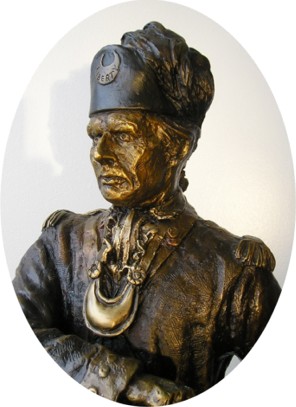 The best one yet: October
19-20, 2007: 5th Francis Marion
Symposium, Manning, SC
The best one yet: October
19-20, 2007: 5th Francis Marion
Symposium, Manning, SCFifth Annual Francis Marion Symposium - 2007 by Chris Swager for SCAR The fifth Gen. Francis Marion Seminar, held on October 19 and 20, 2007 in Manning, SC, pulled off another all-star performance giving the public interesting scholarship and demonstrations. SCAR author, Scott Withrow, presented his paper on the myths and realities of Francis Marion in the 1761 Cherokee campaign which paper will be published in SCAR. The Friday program ended with information about the marsh tacky horses and included a trip to Silver Lakes Plantation to see them work. Eric Nason, dressed in period clothing and taking on the persona of Col. Peter Horry, presented an engaging presentation on Gen. Francis Marion’s most trusted lieutenant. In addition to being a major player in the Southern Campaigns from the beginning of the war through the end, Horry became a general of the SC militia after the war, a member of the SC General Assembly, and namesake of one of South Carolina’s 46 counties. Interestingly at the end of the war, Horry was in a political controversy with his peer, Col. Hesikiah Maham. Eric later demonstrated the difference between 18th Century rifles and muskets, the British and American musket drill and some of the usage of edged weapons of the period. Daniel J. Tortora, a Ph.D. student at Duke University, presented an excellent paper on religion in South Carolina during the Revolutionary War wherein he looked at the experiences of Anglicans, Baptists and Presbyterians. He chronicled early Patriot efforts to secure the support of Anglican clergymen and backcountry Baptists and Presbyterians. He covered the Drayton-Hart-Tennent political mission to the South Carolina backcountry that attempted to sway those residents to join in the rebellion. He traced the constitutional movement to disestablish the Anglican Church and showed how Patriots incorporated religious freedom into the 1778 state constitution. In addition, he described the wartime struggles and divisions of clergy and congregations and detailed the deprivations of South Carolina churches. Religious life was deeply shaken. At war's end, he argued, the Episcopal Church struggled, the Presbyterians slowly rebuilt and the Baptist church united and thrived under the leadership of Revs. Richard Furman and Edmund Botsford as many new churches were constituted. Storyteller and author Christine Swager entertained the attendees by telling about Gen. Marion’s life after the September 1781 Battle of Eutaw Springs. Retired history professor, Joseph Taylor Stukes, gave a dramatic interpretation of SC General Assembly member, Francis Marion, and USC - Sumter history professor, Thomas Powers, replied as US Congressman Thomas Sumter. Both focused on their subject’s post-war political careers. Dr. Powers did an hour in costume as Thomas Sumter and he was magnificent! Dr. Stukes performed for an hour as Francis Marion in his old age wondering how history would record the events of the war - spellbinding. Joe and Tom did an impromptu presentation for the dinner. Marion was on his porch in 1794 when Thomas Sumter, on his way to Charleston, stopped by. The conversation was sharp with Marion prodding Sumter, giving him an opportunity to talk about the war, their mutual disappointment and disgust at the failed 1779 allied Siege of Savannah, the noted personages Sumter had met in Washington, his increasing distrust of the Federalists, and his vision for South Carolina when the canal will allow traffic by water from Charlotte to Charleston. George Summers announced that the Harvin Foundation will donate $5,000.00 for a living history event at Bob Cooper Park in February 2008 to sponsor every third grader in Clarendon County, SC for a day visiting with colonial era gunsmiths, weavers, tanners, candlemakers, etc. This program is patterned after an Over Mountain Victory Trail event at the Mineral Museum in NC where they bus children in from as far as Charlotte for the day. Chris and Robert Swager, Carole and George Summers, Dickie and Lulie Felder, and some Jack's Creek militia reenactors attended this event in 2007 and decided they needed to provide that opportunity for their local Clarendon County, SC kids. So lots of efforts to 'push back the frontiers of ignorance' succeeded in executing this project. |
||||||||||||||||||||||||||||||||||||
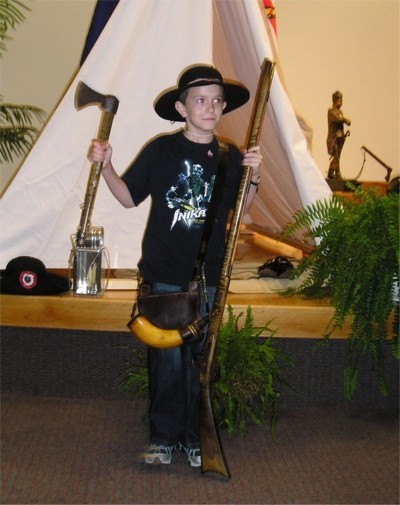
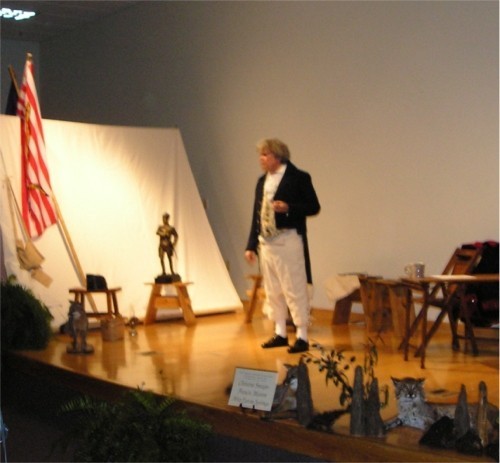
|
||||||||||||||||||||||||||||||||||||
| Report
from the 5th Francis Marion Symposium October 19-20, 2007, Central Carolina Technical College Manning, SC by Dr. Anthony J. Beninati, Valencia Community College, Orlando, FL 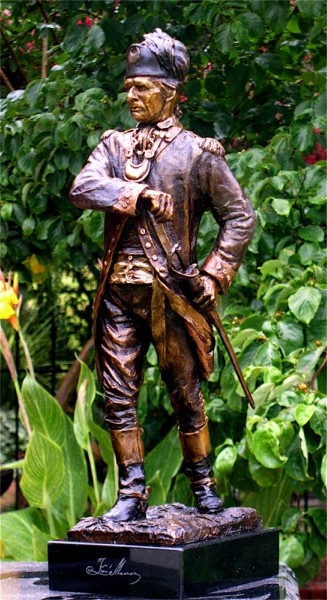
This annual event focuses on the life of General Francis Marion, better known as “The Swamp Fox”, and the role of South Carolina in the American Revolution. Few scholars realize that South Carolina suffered through more battles (63 major encounters with the British and their allies) than all of the other states combined (New York followed with 11). Once the British abandoned their “New England Strategy” to divide the Northeast following the defeat of General Burgoyne and the capture of his army at Saratoga, NY in October, 1777, few major battles occurred in the North. The last significant encounter took place at Monmouth Courthouse, NJ in 1778. In the following year (1779), Britain successfully launched a “Southern Campaign”, quickly taking Savannah, Georgia and then Charleston, South Carolina in 1780. The English strategy counted on their superior naval power to bombard Southern port cities as well as the allegiance of many local Tories, Americans who sympathized with Mother England due to their trade ties and property interests. Absent from their calculations was the cunning home-grown military prowess and anti-British fervor of Patriots such as Francis Marion, William, Horry, Thomas Sumter, and many others, especially backwoods Scots-Irish who took up arms against the invaders and their local allies. Marion would become known as "the greatest guerilla fighter of the American Revolution" during what is called the “Civil War” phase of the Revolution, an era depicted in the film The Patriot, starring Mel Gibson. Photo by Barinowski The conference began with a warm welcome from symposium organizer George Summers, founder of the Swamp Fox Murals Trail Society. He introduced key patrons of the conference and recommended a car tour of the Francis Marion murals on the various public buildings in Clarendon County. Scott Withrow (“Marion among the Cherokees: Myths and Realities”), a semi-retired educator and part-time ranger at Cowpens National Battlefield (site of a key American victory against the British in January, 1781), examined the role of Native Americans in the Revolutionary War in the Carolinas. The war bitterly divided Native Americans across the continent as they resisted colonial intrusions into their homelands but also established close ties to Americans through trade and intermarriage. The northern Iroquois League divided internally when all groups except the Oneida and Tuscarora supported the English, who in 1763 had issued a proclamation prohibited further colonial settlement west of the Allegheny-Appalachian range. 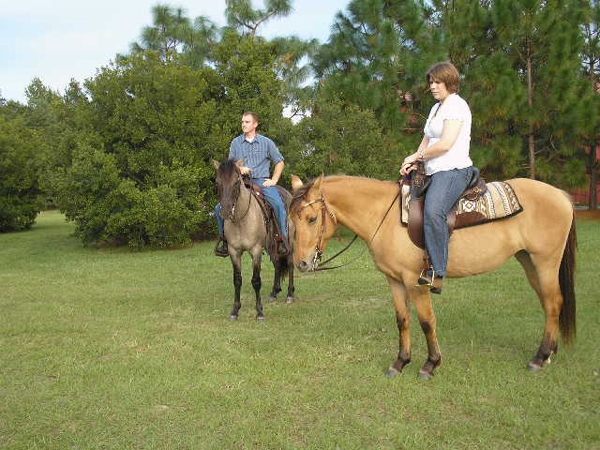 When
the British and their Seneca and
Mohawk allies suffered defeat
at Saratoga by the Patriots, the Oneida,
and the Tuscarora, the Iroquois
League suffered from internal disunity.
A similar situation occurred
in the Carolinas as the largest groups there
– especially the Cherokees – predominately
attempted to remain neutral or aligned
with the British but had factions that
joined the Patriots. The Sioux-speaking
Catawba, traditional enemies of the
Cherokee, joined with Francis Marion to fight
the British, providing important service
as scouts in the inland river areas (“Catawba”
is often translated as “River People”).
The session thus explored the many dimensions
of the difficult position of Native Americans
in what became the United States.
When
the British and their Seneca and
Mohawk allies suffered defeat
at Saratoga by the Patriots, the Oneida,
and the Tuscarora, the Iroquois
League suffered from internal disunity.
A similar situation occurred
in the Carolinas as the largest groups there
– especially the Cherokees – predominately
attempted to remain neutral or aligned
with the British but had factions that
joined the Patriots. The Sioux-speaking
Catawba, traditional enemies of the
Cherokee, joined with Francis Marion to fight
the British, providing important service
as scouts in the inland river areas (“Catawba”
is often translated as “River People”).
The session thus explored the many dimensions
of the difficult position of Native Americans
in what became the United States.Photo by Westfall The second session on Friday afternoon focused on the role of colonial horses in the fighting of the Southern campaign. ln the session "The Marsh Tacky Horse: History on the Hoof", Ms. Jeannette Beranger, Research and Technical Programs Manager of the American Livestock Breeds Conservancy(ALBC), explored the role of the once-common "Marsh Tacky" breed of horses in the American Revolution, particularly among the partisan South Carolina forces. DNA testing reveals that the Marsh Tacky is a descendant of Spanish colonial horses. By the late 1800s, Tackles likely were found as far north as Myrtle 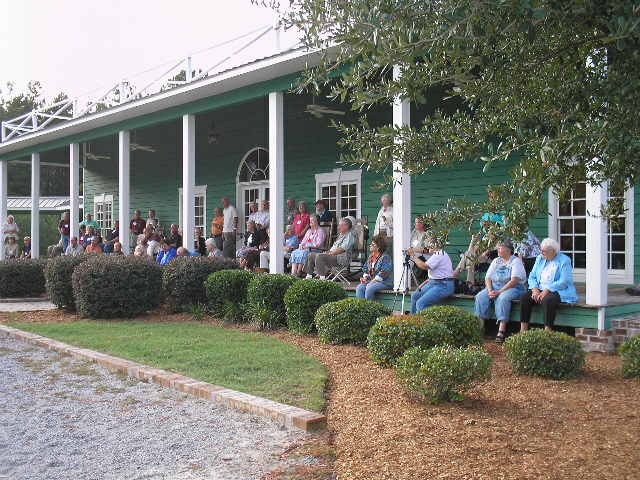 Beach,
SC and as far south as St. Simons
Island, GA. Significantly
smaller (13.5 to 15 hands high)
than Arab or Quarter Horses, the five-foot
tall Tackles were reliable and
good-natured work horses of the Carolina
colonists. Breeders consider the modern-
day Tacky a steady mount ideal for the wetlands
and forests of the region. They do not panic in
mud and water unlike the "blood horses" that
the British imported for many of their officers.
While they had a bulkier body, their long yet narrow
chest efficiently functioned to release heat and
increased their endurance in the sultry Carolina
climate. Marion and his guerrilla warriors saw this
horse as providing a distinct advantage over the
more skittish and less heat-tolerant mounts of the
Redcoat officers.
Beach,
SC and as far south as St. Simons
Island, GA. Significantly
smaller (13.5 to 15 hands high)
than Arab or Quarter Horses, the five-foot
tall Tackles were reliable and
good-natured work horses of the Carolina
colonists. Breeders consider the modern-
day Tacky a steady mount ideal for the wetlands
and forests of the region. They do not panic in
mud and water unlike the "blood horses" that
the British imported for many of their officers.
While they had a bulkier body, their long yet narrow
chest efficiently functioned to release heat and
increased their endurance in the sultry Carolina
climate. Marion and his guerrilla warriors saw this
horse as providing a distinct advantage over the
more skittish and less heat-tolerant mounts of the
Redcoat officers.The evening concluded with a reception at the Silver Lakes Plantation in nearby Paxville, SC where hosts Don and Annamarie Marshall provided symposium participants with an opportunity to see the Marsh Tackies up close. Breeders Janson Cox of the Dragoon Horse Farm and David Grant, an avid horseman, hunter, and colonial era history enthusiast, demonstrated the breed’s ability to travel the backcountry and swamps of the region. Photo by Westfall The Saturday session began as Erick Nason gave a "Living History" presentation on patriot Peter Horry. ln full white "home-spun cotton" militia-garb (unlike the stereotypical woolen blue and red uniforms), "Horry" related episodes in his activities along with trusted friend Francis Marion in the Revolutionary period. He reported on both the difficulties and successes of their campaigns against the British and their local Tory allies. "Horry" also 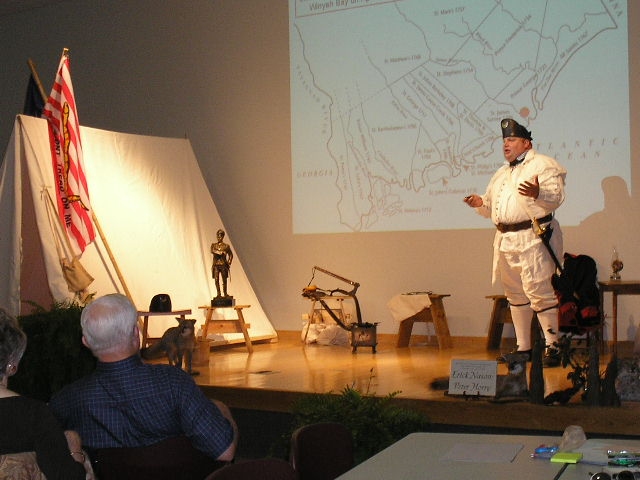 demonstrated
the use of the colonial musket
and differentiated it from
the more sophisticated but less-preferred
rifle as a military firearm.
Likewise, his al|-leather helmet
provided much more practical service
(even as a bowl or water ladle) than a
"tri-cornered hat"! And he confided that
his problem of stuttering or "buck fever"
sometimes inhibited his shouting of commands
at critical times but never impeded his
physical leading of men into a forward charge.
demonstrated
the use of the colonial musket
and differentiated it from
the more sophisticated but less-preferred
rifle as a military firearm.
Likewise, his al|-leather helmet
provided much more practical service
(even as a bowl or water ladle) than a
"tri-cornered hat"! And he confided that
his problem of stuttering or "buck fever"
sometimes inhibited his shouting of commands
at critical times but never impeded his
physical leading of men into a forward charge.In "The Alarm of War: Religion and the American Revolution in South Carolina, 1774-1783", Duke University doctoral candidate Daniel J. Tortora assessed how issues of faith caused rifts during the war. The Anglican (Episcopalian) Church, the "established" official Church of England headed by the King, accounted for approximately 75% of the church membership of the Carolinas. Congregationalist Presbyterians and Baptists composed about 15% of the general population but comprised a much larger percentage of the inhabitants of the backcountry and more ardently supported the Patriot cause. Nevertheless, the official Anglican Church in the Carolinas suffered sharp division among its clergy and membership as many of them offered support for the rebels. Resistance to the "taxes" of the official church often prodded Americans to defect to the patriot side as much as did parliamentary levies! Photo by Westfall Dr. Christine R. Swager, a retired professor of education, storyteller, and author of several notable books on the American Revolution, provided a comprehensive analysis of Marion’s later activities in her presentation "Marion after Eutaw Springs", a major battle that earned a Congressional Medal for the "Swamp Fox". She recounted his struggles with subordinates and colleagues, his retirement to civilian life, his marriage in his 50s, and his success as a planter and member of the legislature prior to his death in 1795. Dr. Thomas Powers, Professor of History at the University of South Carolina, presented a "living history" vignette of the life of “General Thomas Sumter - the Gamecock”, a Carolina veteran of the battlefield and member of the first Congress of the United States in 1789. "Sumter" discussed his ideological struggles as an adherent of "states' rights" as they existed under the Articles of Confederation with his role as a member of the U.S. Congress under the Federalist Constitution. He also explained how this led to a rift between him, Continental General Nathaneal Greene, and Francis Marion due to conflicting lines of military authority between State of South Carolina forces and the congressional Continental Army. Sometimes derided as not being "a team player", “Sumter" argued that the "weathercock" wavering leadership of Governor John Rutledge often left him in an ambiguous military role when the Governor changed his mind about the nature of Sumter’s command of the Carolina forces. The personal appearance of the Swamp Fox himself, General Francis Marion, played by Dr. Joseph Taylor Stukes, retired Professor and Dean at Erskine College and Francis Marion College, touched the heartstrings of the audience. "Marion" recounted his trials and tribulations in service to the Revolution from the perspective of his retirement after the war. Proud that he followed the "rules of engagement", “Marion” noted that his men never looted and that he always observed terms of parole imposed on fellow Patriots released by the British. He fondly examined how South Carolinians rather than the Continental Army "won the war." The Dinner Theater opened with the talented pianist, Norvelle Walker, playing the Richardson Waltz, which is now the SC State waltz and Bea Rivers and Tommy Brown dancing the waltz. Following the dinner featuring dishes such as Mary Esther Videau Cordon Bleu and Spy Nancy Morgan Hart Corn Pudding, Thomas Sumter (Dr. Powers) stopped by to visit Francis Marion (Dr. Stukes). The audience was treated to a dynamic exchange as the two relived their roles in the Southern Campaign. Sponsors 2007: Bank of Clarendon in Manning; Jim & Nell Black of Manning; Black Sheep Promotions, Stephanie & Jeffrey Black of Manning; Citizens Bank of Turbeville; DuBose Campus, Central Carolina Technical College of Manning; Donald L. Ellis, CPA of Manning; FTC of Kingstree; Manning IGA, Lamar Kennedy of Manning; Don & Anna Marie Marshall of Silver Lakes Plantation; NBSC, Bobby Pierce of Manning; Prothro Chevrolet Co., Inc, Lannes Prothro of Manning; Santee Electric, Benton Blakely of Kingstree, SC; SEM Works, Jim Black of Greensboro, NC; George & Carole Summers of Manning, SC. You missed the very best to date: “Marion and the War in South Carolina” Friday, October 19, 2007 Clarendon County Archives & History Center, Manning, has displays open to you today for their 10th Anniversary. Presentationos: Scott Withrow: Francis Marion Among the Cherokee: Myths and Realities J. Beranger & Marsh Tacky owners: The Marsh Tacky Horse: History on the Hoof Jeannette Beranger, The Marsh Tacky Owners and their horses Reception with the Marsh Tacky (to demonstrate their qualities for riding the backcountry and swamps 225 years ago): Silver Lakes Plantation Saturday, October 20, 2007 Revised 10-20-07 Erick Nason: Peter Horry, Marion’s most trusted Confident. Daniel J. Tortora: "The Alarm of War": Religion and the American Revolution in South Carolina, 1774-1783 Peter Horry demonstrates the Manuel to Arms Discussions and Catered Lunch Christine Swager: Marion after Eutaw Springs Joe Stukes as General Francis Marion and T. Powers as General Thomas Sumter Displays and Book Signings Dinner Theater: An Evening in Revolutionary War History When Marion and Sumter Converse; as well as The Richardson Waltz (State Waltz of South Carolina) will be played and waltzed to. This was the 5th Francis Marion Symposium October 19-20, 2007 The Marsh Tacky: South Carolina Farmer Magazine provides background about the Marsh Tacky. Recent DNA testing shows the marsh tacky is a descendant of Spanish colonial horses. By the late 1800s, tackies were reported to have been found in the area as far north as Myrtle Beach and as far south as St. Simons Island, Ga. Tackies were found all over St. Helena, Daufuskie and Hilton Head islands up through the 1950’s. The little horses -- which stand about 5 feet tall and are known for their sure-footedness, their gentle dispositions and their ability to remain calm in the water -- were used for transporting goods, plowing and providing private transportation for children and adults. Tackies more than 50 years ago were on Hilton Head Island and brought over on a ferry. Tackies began disappearing after people stopped farming on the islands; and when the bridge to Hilton Head Island was built in the 1950s. Tackies have a good temperament, long manes, tails that drag to the ground and hips that turn straight down instead of rounded like quarter horses. Also, the horse is easy to break in for riding. Francis Marion’s militia probably would have ridden the marsh tacky 225 years ago and Tarleton's men did too. |
||||||||||||||||||||||||||||||||||||
|
Site
Location:
Central
Carolina Technical
College,
FE
DuBose Campus, Manning, SC.
This is on US 521, 1 mile east of I-95, exit 122. Manning, SC 29102 See Francis Marion related items for sale. |
||||||||||||||||||||||||||||||||||||
|
Mr.
C. Hester, Treasurer
PO Box
667
Manning,
SC 29102
|
||||||||||||||||||||||||||||||||||||
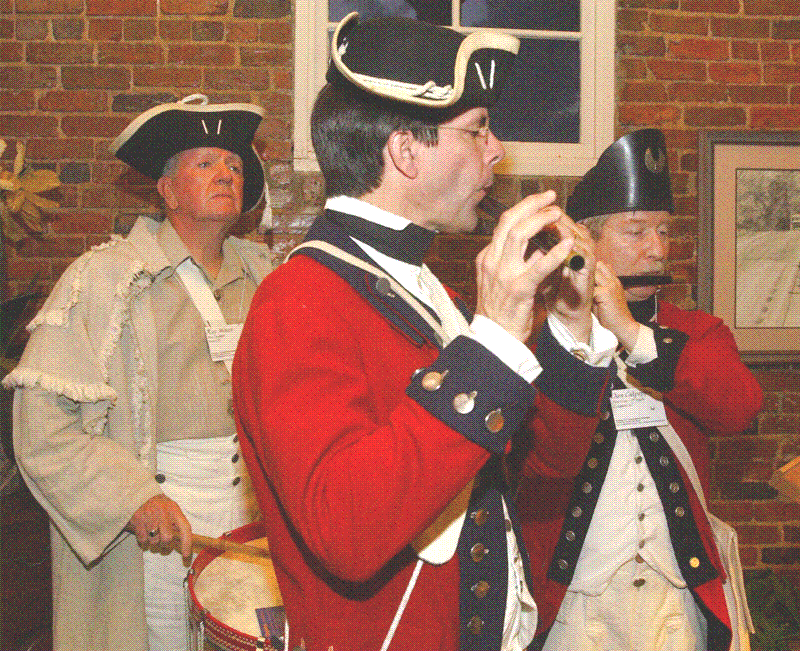
Drum and fifes (Ray Moran, Garland Hart and Dan Culpepper) at Francis Marion
Symposium 2005 were a big hit.
|
||||||||||||||||||||||||||||||||||||
|
By Sandi Chaney in
The Item
Karen MacNutt came from Massachusetts for the second year in a row to learn about Francis Marion and area history. “I have been a big Revolutionary War fan, in particular a fan of the Southern campaign, and in particular a fan of Francis Marion for more years than I can remember,” she said, “probably from the time that Walt Disney created the “Swamp Fox” television productions with Leslie Nielsen. But I quickly realized the man (Marion) was much more complex, much more interesting than he's ever been portrayed in fiction. I've read a lot of biographies, and many people who were in the army during the Revolutionary War were pretty shallow. But some are real patriots and have quite a depth. I think Marion felt the cause passionately.” MacNutt believes there are some valuable
life lessons to be learned
from studying Marion's
life and times – lessons
that transcend the man himself.
“They had nothing,
really,” she said. “Everybody
was surrendering, but
he didn't do that. He kept
going, and by the force of his own
character, he kept things together.
It's a lesson we can all learn,
that if something is worth
having, it requires you to
fight hard for it. The fact that
you don't have everything you need
or you don't have the best of everything
just means you have to be smarter than
the next guy. And if you have
that force of character, that force
of will, the commitment, and a belief in
something bigger than yourself, you
will have the advantage.” |
||||||||||||||||||||||||||||||||||||
|
Motel Accommodations near Exits on I-95 in South Carolina Motels at exit 119 are closest to Symposium site CCTC at exit 122. American's Best Inn - Exit 108 Summerton Book your own room!
Questions: Francis
Marion Symposium
|
||||||||||||||||||||||||||||||||||||
|
||||||||||||||||||||||||||||||||||||
|
Early Francis Marion
Symposium History 2003-2006
|
||||||||||||||||||||||||||||||||||||
|
Many of these engagements took place in the Clarendon County area. According to Professor Henry Lumpkin about a third of all battles were fought in S.C. and Marion had a hand in roughly a third of those. During this symposium we want to explore the man, the tactics and the effect he had on the overall war effort. |
||||||||||||||||||||||||||||||||||||
|
Make check payable to Francis Marion Symposium (non-refundable after 10/9/10) Mail to: Francis Marion Symposium Questions call 803-478-2645 or E-mail gcsummers@ftc-i.net Book your own room and advise motel you are attending
symposium
for the special rates.
|
||||||||||||||||||||||||||||||||||||
|
||||||||||||||||||||||||||||||||||||
 ©2001
©2001
Marion designated "Swamp Fox" by Tarleton at Ox Swamp Swamp Fox Mural Trail - Manning, SC |
|
(non-refundable after 10/8/11) Mail to: Francis Marion Symposium PO Box 667 Manning, SC 29102 Questions call 803-478-2645 or E-mail: gcsummers@ftc-i.net Book your own room and advise motel you are attending
symposium
for the special rates.
|
 ©2002
©2002
Battle of Tearcoat Swamp at night - Swamp Fox Mural Trail - Turbeville, SC
 ©2002
©2002
Siege of Fort Watson is mural in Summerton on Swamp Fox Murals Trail.
Check out: South Carolina's Front
Door Website:
SCIway
- The South
Carolina Information
Highway
or Clarendon Murals or Swamp Fox Murals Trail
| Site maintained by Francis Marion Symposium Webmaster |